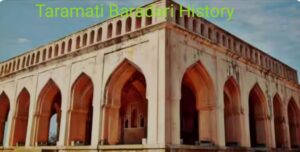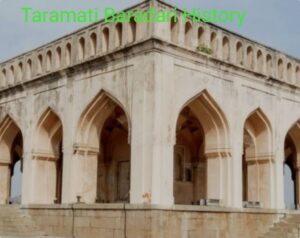The heart of Hyderabad, Taramati Baradari History,stands as a timeless testament to the city’s historical grandeur. This introduction offers a brief overview of the enchanting monument, tracing its roots to the 17th century during the reign of Sultan Abdullah Qutb Shah. Taramati Baradari, initially designed as a sarai, evolved into a cultural sanctuary, hosting musical performances and gatherings. Its architectural brilliance of the Qutb Shahi dynasty ornamentation and a strategically designed courtyard, sets the stage for a journey into the past. Join us as we unravel the layers of Taramati Baradari’s history, where each brick resonates with the echoes of a bygone era.

1. Taramati Baradari History
A. Construction period and purpose
Constructed during the 17th century under the patronage of Sultan Abdullah Qutb Shah, Taramati Baradari stands as a testament to the architectural brilliance of the Qutb Shahi dynasty. Initially designed as a sarai, or roadside inn, it served as a vital stop for travelers navigating the trade routes of the Deccan plateau. The strategic location, between Golconda Fort and the Qutb Shahi Tombs, emphasized its utilitarian purpose. Beyond its architectural splendor, the Baradari’s early years were defined by its role as a functional wayfarer’s haven in the heart of historical Hyderabad.
B. Architectural features and significance
Taramati Baradari’s architectural splendor showcases the finesse of the Qutb Shahi dynasty. With its open pavilion design, the structure boasts twelve intricately adorned doorways and windows, featuring exquisite stucco ornamentation. The layout provides both ventilation and a breathtaking panorama. Beyond aesthetic appeal, the acoustically designed courtyard emphasizes its significance as a cultural venue. This marriage of form and function in the architectural features of Taramati Baradari not only reflects the era’s artistic prowess but also underscores its role as a multifaceted space for cultural expression and communal gatherings.
C. Cultural and historical context
Taramati Baradari’s cultural and historical context unfolds within the vibrant tapestry of the Qutb Shahi era. As a creation of Sultan Abdullah Qutb Shah in the 17th century, it mirrors the architectural and cultural zeitgeist of that period in Hyderabad. The Baradari’s dual role as a sarai for travelers and a cultural venue for artistic gatherings speaks to the dynamic nature of society during the Qutb Shahi dynasty. It stands as a living testament to the convergence of architectural brilliance, cultural richness, and historical significance in the heart of Deccan history.
2. Taramati Baradari History: Taramati Baradari’s Cultural Significance
A. Connection to Taramati, the courtesan
Taramati Baradari holds a unique connection to Taramati, a courtesan of legendary repute during the Qutb Shahi era. As the story goes, Taramati’s ethereal voice captured the attention of the seventh Sultan, Abdullah Qutb Shah. Enamored by her musical talents, the Sultan built the Baradari to serve as a venue for their clandestine meetings. Taramati’s performances within its acoustically designed walls further added to the cultural allure of the Baradari, intertwining the destinies of the courtesan and this architectural gem in a captivating tale of love, music, and history.
B. Role in entertainment and gatherings during its prime
During its prime, Taramati Baradari played a pivotal role as a hub for entertainment and cultural gatherings in Hyderabad. The expansive open pavilion, surrounded by lush gardens, set the stage for a variety of events, ranging from musical performances to artistic gatherings. Its acoustically designed courtyard became a showcase for the mesmerizing tunes of the era, with Taramati’s performances adding an enchanting touch. The Baradari, with its regal ambiance, became a favored venue for the nobility, fostering a vibrant cultural scene and leaving an indelible mark on the social life of its time.
C. Influence on local art and music
Taramati Baradari exerted a profound influence on local art and music, becoming a crucible of creativity in Hyderabad. The cultural gatherings held within its walls provided a platform for local artists and musicians to showcase their talents. The acoustically designed architecture enhanced musical performances, contributing to the development of distinctive regional styles. The Baradari’s cultural patronage not only enriched the artistic landscape of its time but also left an enduring legacy, influencing the evolution of local art and music in the Deccan region.

3. Taramati Baradari History:Decline and Restoration
A. Factors contributing to the decline
The decline of Taramati Baradari can be attributed to various factors that unfolded over the centuries. Firstly, changing political landscapes and the decline of the Qutb Shahi dynasty led to a decrease in royal patronage, impacting the maintenance of the monument. Additionally, natural wear and tear, exacerbated by environmental factors, took a toll on the structural integrity of the Baradari. Neglect during certain periods and a lack of sustained conservation efforts further contributed to its gradual deterioration. These combined factors culminated in the decline of Taramati Baradari over time.
B. Periods of neglect and deterioration
Taramati Baradari faced periods of neglect and deterioration due to shifting political landscapes, waning royal patronage, and environmental factors. The monument endured phases of abandonment, impacting its structural integrity. Lack of consistent conservation efforts further exacerbated its decline, marking chapters of neglect in the historical narrative of this once-grand architectural gem.
C. Efforts taken for restoration and preservation
Efforts to restore and preserve Taramati Baradari have been underway in recent years. Government agencies, historical preservation organizations, and local communities have collaborated to initiate restoration projects. These endeavors involve structural repairs, conservation of ornate details, and landscaping to revive the Baradari’s former glory, ensuring its cultural and historical significance endures for future generations.
4. Taramati Baradari History: Architectural Marvels of Taramati Baradari
A. Intricate design elements
Taramati Baradari’s intricate design elements are a testament to the skilled craftsmanship of the Qutb Shahi era. The structure features arched doorways and windows adorned with detailed stucco ornamentation. The open pavilion design, with its twelve doorways, not only serves aesthetic purposes but also showcases a meticulous blend of artistic finesse and architectural functionality.
B. Unique features that set it apart
What sets Taramati Baradari apart are its unique features that seamlessly blend aesthetics with purpose. The acoustically designed open pavilion, the regal stucco ornamentation adorning arched doorways, and the strategic positioning offering panoramic views collectively distinguish it. This synthesis of architectural innovation and cultural sensitivity makes Taramati Baradari an unparalleled historical gem.
C. Comparison with other historical structures of the time
In comparison with other historical structures of the Qutb Shahi era, Taramati Baradari stands out for its distinctive fusion of functional and cultural elements. While structures like Golconda Fort showcase military might, the Baradari’s dual role as a sarai and a cultural hub makes it unique. Its open pavilion design and acoustically designed courtyard differentiate it from contemporaneous monuments, underscoring the Qutb Shahi dynasty’s multifaceted architectural legacy.
5.Taramati Baradari History: Taramati Baradari in Modern Times
A. Visitor experiences and tourism impact
Visitor experiences at Taramati Baradari are marked by a journey into Hyderabad’s rich history. Tourists are captivated by its intricate architecture, lush surroundings, and the echoes of cultural events. The site’s tourism impact extends beyond its historical allure, contributing to the local economy and fostering an appreciation for the region’s cultural heritage. As visitors explore the Baradari, they not only witness a historical marvel but also actively participate in preserving and celebrating Hyderabad’s vibrant past.
B. Events and activities hosted at Taramati Baradari
Taramati Baradari hosts a variety of events and activities that breathe life into its historical surroundings. Cultural festivals, classical music performances, and art exhibitions grace its open pavilion. Additionally, the venue is often chosen for weddings, adding a touch of regality to celebratory occasions. These diverse events contribute to Taramati Baradari’s dynamic role as a cultural and social nexus in contemporary times.

6. Importance of Preserving Historical Landmarks
A. Cultural identity and heritage conservation
Taramati Baradari embodies cultural identity, serving as a poignant link to Hyderabad’s historical and artistic legacy. Its conservation is not merely a restoration of bricks and mortar but a commitment to preserving the essence of the Deccan’s cultural identity. By safeguarding such heritage, communities actively contribute to a collective memory, fostering a deeper understanding of their roots and ensuring that the echoes of the past resonate with generations to come.
7. Tips for Visiting Taramati Baradari
A. Best times to visit
The best times to visit Taramati Baradari are during the cooler months, typically from October to March. Hyderabad experiences milder temperatures during this period, providing a more comfortable environment for exploring the historical site. Additionally, these months coincide with the festive season, offering a chance to witness cultural events and performances that may be hosted at the Baradari.
B. Nearby attractions for a complete historical experience
For a comprehensive historical experience, consider exploring nearby attractions in Hyderabad:
1.Golconda Fort: Immerse yourself in the grandeur of Golconda Fort, a colossal structure with a rich history and stunning architecture.
2.Qutb Shahi Tombs: Discover the mausoleums of the Qutb Shahi rulers, showcasing a blend of Persian, Pashtun, and Hindu architectural styles.
3.Charminar: Dive into the heart of Hyderabad’s Old City with Charminar, an iconic monument surrounded by bustling markets and vibrant culture.
4.Mecca Masjid: Witness the grandeur of one of the largest mosques in India, known for its exquisite architecture and historical significance.
5.Salar Jung Museum: Delve into a vast collection of art, artifacts, and manuscripts at the Salar Jung Museum, showcasing the diverse cultural history of India.
Exploring these nearby attractions will offer a holistic journey through Hyderabad’s rich and diverse historical heritage.
Conclusion:
Taramati Baradari historical journey is a captivating narrative of architectural brilliance, cultural resonance, and the intertwining of royal romance. From its origins as a sarai to the cultural haven that echoed with Taramati’s melodies, each brick holds tales of a bygone era. Despite periods of neglect, concerted efforts have revived this gem, allowing visitors to witness its past glory. As we stand amidst its arched doorways and lush courtyards, Taramati Baradari becomes not just a historical monument but a living testament to the enduring spirit of Hyderabad’s rich history, beckoning all to immerse in its timeless charm.
FAQs:
1.What is the meaning of taramati baradari?
2.Who is Queen Taramati?
3.Taramati baradari history wikipedia
4.Taramati baradari history in english
5.Taramati Baradari history in Telugu
6.Taramati Baradari entry fee
7.Who built taramati baradari
8.Who is Taramati


Pingback: the Mystical Beauty of Basara Jnana Saraswati Temple - solotraveler
Pingback: Manjira River in Hyderabad: A Journey Through best Time and Tradition - solotraveler
Pingback: Epic Holi 2024 Moments: Get Ready for a Colorful Adventure - solotraveler
Pingback: Home-Cooked Jalebi Recipe : A Sweet Treat You Can’t Resist - solotraveler